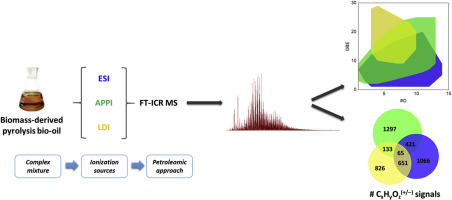Accueil du site > Production scientifique > Combination of electrospray ionization, atmospheric pressure photoionization and laser desorption ionization Fourier transform ion cyclotronic resonance mass spectrometry for the investigation of complex mixtures – Application to the petroleomic analysis of bio-oils
Combination of electrospray ionization, atmospheric pressure photoionization and laser desorption ionization Fourier transform ion cyclotronic resonance mass spectrometry for the investigation of complex mixtures – Application to the petroleomic analysis of bio-oils
Date de publication: 22 mars 2017
J. Hertzog, V. Carré, Y. Le Brech, C. Logan Mackay, A. Dufour, O. Mašek, F. Aubriet
Analytica Chimica Acta 969 26-34 (2017). DOI
Travail réalisé sur le site de l’Université de Lorraine.
Abstract

The comprehensive description of complex mixtures such as bio-oils is required to understand and improve the different processes involved during biological, environmental or industrial operation. In this context, we have to consider how different ionization sources can improve a non-targeted approach. Thus, the Fourier transform ion cyclotron resonance mass spectrometry (FT-ICR MS) has been coupled to electrospray ionization (ESI), laser desorption ionization (LDI) and atmospheric pressure photoionization (APPI) to characterize an oak pyrolysis bio-oil. Close to 90% of the all 4500 compound formulae has been attributed to CxHyOz with similar oxygen class compound distribution. Nevertheless, their relative abundance in respect with their double bound equivalent (DBE) value has evidenced significant differences depending on the ion source used. ESI has allowed compounds with low DBE but more oxygen atoms to be ionized. APPI has demonstrated the efficient ionization of less polar compounds (high DBE values and less oxygen atoms). The LDI behavior of bio-oils has been considered intermediate in terms of DBE and oxygen amounts but it has also been demonstrated that a significant part of the features are specifically detected by this ionization method. Thus, the complementarity of three different ionization sources has been successfully demonstrated for the exhaustive characterization by petroleomic approach of a complex mixture.








